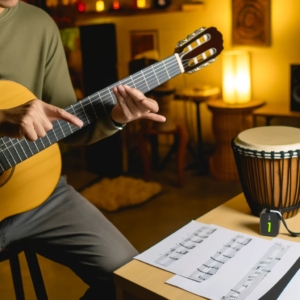Mastering Guitar: Enhancing Hand Strength and Dexterity
Mastering the guitar is not just about knowledge; it’s also about physical prowess. Developing hand strength and dexterity is essential for executing complex chords, lightning-fast solos, and intricate fingerpicking patterns. In this blog post, we’ll delve into effective exercises and techniques designed to enhance your finger strength, agility, and overall playing ability. Whether you’re a beginner or an experienced guitarist, building hand strength and dexterity will unlock new levels of musical expression.
The Foundation: Hand Warm-Up
Just as athletes warm up before a workout, guitarists should warm up their hands before diving into practice. Begin with gentle stretching and flexing exercises to loosen your fingers and wrists. Gradually increase the intensity to get your blood flowing and prepare your muscles for the practice session ahead.
Hand Warm-Up Exercises:
- Finger Stretches: Extend your hand and stretch each finger individually.
- Wrist Rotations: Rotate your wrists clockwise and counterclockwise to loosen up.
- Finger Taps: Tap each finger to your thumb to increase finger flexibility.
Finger Independence and Control
Spider Walks
Spider Walks are excellent for enhancing finger independence and stretching your hand. Place your fingers on adjacent frets, like a spider’s legs. Start with the index finger and move across the fretboard, maintaining a steady rhythm.
Finger Rolls
Play each finger in sequence across the strings, creating a rolling motion. This exercise improves finger control and helps develop a smooth, even attack.
Strength-Building Exercises
Finger Push-Ups
Place your fingertips on a flat surface, like a table or your guitar’s body, and press down as if doing push-ups. This exercise strengthens your fingertips and improves overall finger strength.
String Squeezes
Hold down a barre chord shape on one fret and squeeze the strings with your fingers. Maintain the pressure for a few seconds before releasing. Repeat on different frets to work on different finger combinations.
Fingerpicking Patterns and Arpeggios
PIMA Technique
Assign your fingers to the following strings: P – Thumb (pulgar), I – Index, M – Middle, A – Ring. Practice plucking strings in various patterns using these fingers to build finger strength and control.
Arpeggio Exercises
Practice arpeggios using different chord shapes. Start with slow, deliberate motions and gradually increase the speed. This exercise improves finger coordination and accuracy.
Trill Exercises
Hammer-Ons and Pull-Offs
Alternate between hammering-on and pulling-off a single note with each finger. This technique improves both finger strength and the fluidity of your playing.
Trill Patterns
Select two adjacent frets and trill between them using your fingers. Start slow and gradually increase the speed. This exercise is excellent for building finger endurance.
Metronome Training
Incorporate a metronome into your practice routine to maintain a steady tempo. Start at a comfortable speed and gradually increase it as you become more comfortable with the exercise. Consistent metronome training improves precision and timing.
Comprehensive Practice Routine
To integrate these exercises into a comprehensive practice routine, follow these steps:
- Warm-Up (5-10 minutes): Begin with hand warm-up exercises to prepare your muscles.
- Finger Independence (10-15 minutes): Practice Spider Walks and Finger Rolls.
- Strength-Building (10-15 minutes): Alternate between Finger Push-Ups and String Squeezes.
- Fingerpicking and Arpeggios (10-15 minutes): Focus on the PIMA Technique and arpeggio exercises.
- Trill Exercises (10-15 minutes): Incorporate Hammer-Ons, Pull-Offs, and Trill Patterns.
- Metronome Training (5-10 minutes): Use a metronome to practice all exercises with a steady rhythm.
Conclusion
As a guitarist, your hands are your most valuable assets. Building hand strength and dexterity is a continuous journey that yields substantial rewards. By incorporating hand warm-ups, finger independence exercises, strength-building drills, fingerpicking patterns, arpeggios, trill exercises, and metronome training, you’re cultivating the physical foundation necessary to execute intricate techniques and express your musical ideas with finesse. Remember, progress takes time, so approach these exercises with patience and dedication. As you embark on this journey of hand improvement, you’ll witness your guitar playing evolve, allowing you to tackle challenging pieces and create beautiful melodies with newfound ease and confidence.
—
Interested in exploring music? Schedule a free trial lesson, either online or in-person, by filling out this form, and we’ll get back to you within 24 hours.




